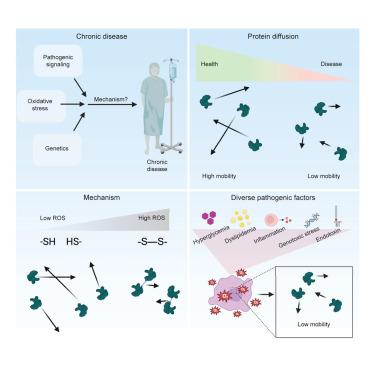Proteolethargy is a pathogenic mechanism in chronic disease
IF 42.5
1区 生物学
Q1 BIOCHEMISTRY & MOLECULAR BIOLOGY
引用次数: 0
Abstract
The pathogenic mechanisms of many diseases are well understood at the molecular level, but there are prevalent syndromes associated with pathogenic signaling, such as diabetes and chronic inflammation, where our understanding is more limited. Here, we report that pathogenic signaling suppresses the mobility of a spectrum of proteins that play essential roles in cellular functions known to be dysregulated in these chronic diseases. The reduced protein mobility, which we call proteolethargy, was linked to cysteine residues in the affected proteins and signaling-related increases in excess reactive oxygen species. Diverse pathogenic stimuli, including hyperglycemia, dyslipidemia, and inflammation, produce similar reduced protein mobility phenotypes. We propose that proteolethargy is an overlooked cellular mechanism that may account for various pathogenic features of diverse chronic diseases.

蛋白质缺乏症是慢性疾病的致病机制之一
许多疾病的致病机制在分子水平上都很清楚,但对于糖尿病和慢性炎症等与致病信号转导相关的流行综合征,我们的了解则较为有限。在这里,我们报告了致病信号抑制了一系列蛋白质的流动性,这些蛋白质在细胞功能中发挥着至关重要的作用,而这些细胞功能在这些慢性疾病中被认为是失调的。蛋白质流动性的降低(我们称之为 "蛋白质倦怠")与受影响蛋白质中的半胱氨酸残基以及信号相关的活性氧过量增加有关。包括高血糖、血脂异常和炎症在内的多种致病刺激会产生类似的蛋白质流动性降低表型。我们认为,蛋白质惰性是一种被忽视的细胞机制,可能是各种慢性疾病的致病特征的原因。
本文章由计算机程序翻译,如有差异,请以英文原文为准。
求助全文
约1分钟内获得全文
求助全文
来源期刊

Cell
生物-生化与分子生物学
CiteScore
110.00
自引率
0.80%
发文量
396
审稿时长
2 months
期刊介绍:
Cells is an international, peer-reviewed, open access journal that focuses on cell biology, molecular biology, and biophysics. It is affiliated with several societies, including the Spanish Society for Biochemistry and Molecular Biology (SEBBM), Nordic Autophagy Society (NAS), Spanish Society of Hematology and Hemotherapy (SEHH), and Society for Regenerative Medicine (Russian Federation) (RPO).
The journal publishes research findings of significant importance in various areas of experimental biology, such as cell biology, molecular biology, neuroscience, immunology, virology, microbiology, cancer, human genetics, systems biology, signaling, and disease mechanisms and therapeutics. The primary criterion for considering papers is whether the results contribute to significant conceptual advances or raise thought-provoking questions and hypotheses related to interesting and important biological inquiries.
In addition to primary research articles presented in four formats, Cells also features review and opinion articles in its "leading edge" section, discussing recent research advancements and topics of interest to its wide readership.
 求助内容:
求助内容: 应助结果提醒方式:
应助结果提醒方式:


